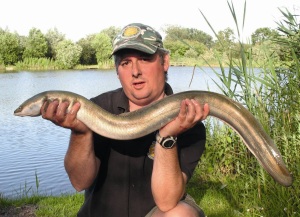You are here
Eel Friendly Fisheries Scheme
The National Anguilla Club is one of the country’s longest running specimen angling clubs being formed back in 1962. Its membership has fluctuated between 10 to 50 members but is now at an all time high with well over 100 senior members. In the early days some eels were killed by the membership so that in-depth studies could be carried out to better understand this mysterious creature. The freshwater eel population is in serious decline, the club has evolved to meet the challenges that face the eels future with the appointment of environmental officers and a hard line approach to eel conservation issues. The eel has declined by 99% since the 1980s and a pan European research Group under the title of Indicang has proven that the situation is now critical. To put this in perspective the European freshwater eel is currently deemed the most at risk vertebrate in the country and is on the International Union for Conservation of Nature ( ICUN ) Red list. This list contains species at risk and is split into categories depending on the severity of the risk, the eel is currently classed as critically endangered, the next stage is Extinct in the Wild. To combat the challenge’s facing the freshwater eel the National Anguilla Club is launching a new scheme that hopes to highlight how we as anglers and fishery owners can make a difference.
The Eel Friendly Fishery Scheme is open to commercial fisheries, Clubs and Association’s and a fishery can achieve eel friendly status following a successful application. The fishery would have met the criteria required and agreed to enhance the eel’s habitat where possible within the fishery. The NAC can advise the fishery on habitat improvements. These can be as simple as leaving a small area of the lake to remain overgrown and weedy to placing sunken pipes and floating islands in a designated area. The main criteria is the adoption of a code of practice. This code relates to the eel within the fishery environment and is fundamental to the process, the code contains aspects relevant to anglers and fishery owners. Many people have a preconceived view of eels and, like sharks, they suffer from a poor overall image usually attributed to their snakelike appearance and movement. In reality the freshwater eel is a valuable asset to the fishery environment and nearly all lakes, ponds and canals still contain a stock of mature eels.

Many of these resident eels are mature females remaining within a watercourse until the time is right for them to migrate back to the Sargasso Sea. Eels are extremely slow growing and a rule of thumb is that an eel takes 10 years to grow 1lb in weight. So a 5lb specimen eel could be as much as 50 years old. These large female eels are the most sought after by the NAC membership as the male eel rarely exceeds 2lbs and an eel needs to top 4lb to be classed as a specimen. As a fishery owner or angler why should the decline of the eel make any difference to you?
Well, as a keystone species the eel is an integral part of the food chain. Otters have historically fed on a rich diet of eels previously abundant within the country’s river systems. The decline in eels has surely led to the modern otter finding alternative prey in the form of lake fish. Many modern fisheries do not contain predators but are subject to the occasional fish fatality. Eels clean up the dead and dying, thereby helping to prevent disease.
The Club has also begun to discover a connection with crayfish that could be beneficial in the removal of the infamous signal crayfish. Waters with large heads of crayfish seem to be devoid of eels and waters with a good population of eels have few or no crayfish.
Eels are perfectly designed for hunting crayfish and can enter their burrows easily, several members have caught large eels that have regurgitated crayfish. I hope that anglers and fishery owners will see the benefits in conserving the freshwater eel and do something positive by signing up to the Eel Friendly Fishery Scheme.
Anyone interested in finding out more about the eel and the National Anguilla Club can visit the clubs website at: www.nationalanguillaclub.co.uk
To find more about The Eel Friendly Fishery Scheme contact Steve Dawe at: [email protected]
